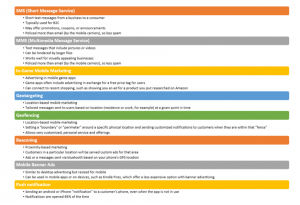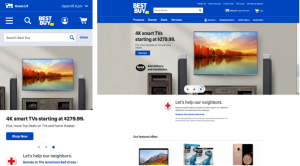Module 3: Readings and Videos Part III

Overview
Technology changes and grows every day, and digital marketing needs to stay adaptable and flexible to change or adjust as needed. This week we will discuss some of the newer technologies in digital marketing and exploring upcoming potential trends to keep an eye on. We will also discuss the impact that the mobile revolution has had on marketing.
Module Objectives
Upon completion of this part of the module, you should be able to:
- Describe the key factors that differentiate mobile usage from desktop usage.
- Discuss key factors that differentiate mobile users from desktop users.
- Determine unique opportunities for targeting mobile users.
- Research current trends and technology and analyze for practical marketing use.
- Identify technology innovations or development that may be applicable to marketing in the future.
Mobile Marketing
Over the past few years, mobile devices have played an increasingly large role in digital marketing. Mobile web traffic has surpassed desktop web traffic, and for the first time in known history, people have a device that gives them access to the Internet and mobile network virtually 24/7. And it gives businesses 24/7 access to consumers.
While email marketing struggles to overcome Full-Inbox-Syndrome (meaning your email may be deleted unread or ignored because people already get too much email), people typically check their phones quickly when they receive a notification. Text marketing has been effective because consumers actually welcome text messages from their favorite stores, restaurants, or other businesses.
Provided below are some definitions of common mobile marketing terms.

Mobile Websites
Today, consumers are on their phones off and on all day long, and we tend to use our cell phones for quick searches or to answer immediate questions. And how many of us are practically addicted to our phones? Have you ever measured how many minutes a day you spend on your phone on average? I bet you’d be surprised. Many people check their cell phones first thing in the morning, and it’s also the last thing they look at before they sleep.
Because we are now so completely dependent on our phones, it’s imperative that businesses design their websites to be mobile-responsive, which means the website changes in appearance based on the size of the screen, regardless of the device. But designing a website for a cell phone comes with some challenging constraints, such as less room for content, fat-finger clicking (which means tiny links are harder to click), slower processors, and slower internet connection speeds.

Above and beyond the physical and technical limitations of a small screen, mobile phones also change consumer behavior. People have limited attention spans for long blocks of text, and they tend to browse for quick answers and results. People also tend to search locally more frequently on a cell phone. When designing a website, it’s important to take into account behavior as well as technology.
Location-Based Targeting
With mobile marketing, geography is far more important than it is on a desktop. Because cell phones are more often on the move, it’s important to reach out to people when they’re within a reasonable distance of a specific business. As distance increases from the location, the probability of response to an ad decreases. This is where location-based marketing comes into play. The graphic above defines geotargeting, geofencing, and beaconing, which are all forms of location-based targeting. Depending on where you look them up, marketers may use the terms geotargeting and geofencing interchangeably, but they are actually two different tactics.
Geofencing enables a company to set a perimeter around a specific physical location to send tailored messages or ads to targeted customers within that fence. Geofencing hones in on specific targeting criteria (i.e., demographics, behaviors, interests) and provides customized, personal service and offerings. Geotargeting is a tailored messaging or advertising based on location (residence or work, for example) at a given point in time rather than within a specific boundary.
Beaconing is a bit different. Beaconing is proximity-based marketing, but instead of creating a boundary or a virtual fence that sets the location, customers will set up an actual physical beacon, and if their target market is within range of the beacon, they will send ads or bluetooth messages via the location services on the target’s phone. This type of geomarketing typically relies on an app. You may have actually seen this in action if you’ve ever opened the Target app while you’re physically inside Target or a grocery store app while you’re physically inside the grocery store.
For example, I have the King Soopers (The Colorado version of Kroger grocery stores) app on my phone. If I’m actually inside King Soopers, my app layout changes. It shows me where to find the items on my list and which items have coupons. It tells me what’s on sale in the aisle I’m currently in that may appeal to me. Beaconing really lets a company customize to a given customer in a way no other tactic can quite do.
With all geomarketing tactics, there are multiple elements to take into consideration. To know what messages or promotions to send, a business needs to know the customer’s behavior.

Consider the following See’s Candy store in a mall. Where would the ideal target audience be coming from within the mall? From which direction would they approach? What time of day might be more effective for promotions than others? If their customer is trying to move quickly through the mall without stopping, a company may choose not to promote or to focus on quick service. If a customer is meandering but on the opposite side of the mall, the message may need to be a strong enough incentive to distract them from the stores on the other side of the mall.
Mobile Apps
Another method of using mobile marketing that has grown in popularity over the past few years is having a dedicated mobile app for your business. The benefit of using a mobile app for your business is the ability to provide an improved user experience. Creating a customer experience that increases convenience, money savings, time savings, or enjoyment leads to increased loyalty and increased sales.
Third-Party Apps
Some businesses use an existing third-party app tailored to their needs. For example, Tokyo Joe’s allows people to look through their menu, choose a location, place an order, and specify a pick-up time all through an app developed by Splick-It. Customers can then walk into the restaurant, skip the line, pick up their order, and be on their way. This provides convenience and time savings to their customers, so in turn, leads to higher sales. Other examples of third-party apps used here in the Denver area are Neptune’s Tropical Fish, which uses a third-party app to track visits and provide loyalty rewards, and Westrail Tap and Grill, which uses a third-party app to notify visitors when their table is ready.
Custom Apps
As an alternative, a company can also create their own customized app. Monterey Bay Aquarium, for example, has two apps dedicated to improving customer and member experience. The Aquarium App allows visitors to use an interactive map, learn additional facts about the exhibits, and plan their day at the aquarium. It saves the aquarium visitor time and makes their life easier. They have a second app, the Seafood Watch App, that allows users to look up restaurants and local businesses to find out whether the seafood they’re serving is sustainable. This builds their brand as a conservationist organization and allows members the benefit of supporting a cause that’s important to them.
An example of a business-to-business customized app would be the mobile app that Salesforce has to supplement its cloud-based CRM databases. Because their products and services are available on the cloud, people can use them from a desktop or laptop and also from their mobile phone. This allows Salesforce customers to access their CRM database from anywhere at any time, providing additional convenience and efficiency to the business customer.
Marketing Trends
One of the challenges inherent in digital marketing is that technology and practices are always changing. Google changes its SEO algorithm frequently, sometimes daily. Facebook changes the layout, regulation of content, and how it shares content. In an online course, we could post immediate, up-to-date trends that expire by the time class starts. To understand marketing trends and foresee which may be most useful, a marketer should research current marketing tactics regularly as well as changing technology that could provide new marketing opportunities in the future. In this week’s discussion forum, you will have the opportunity to put this research into practice.

